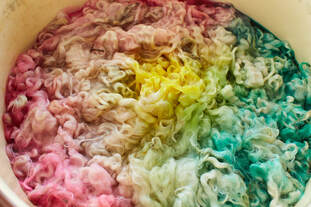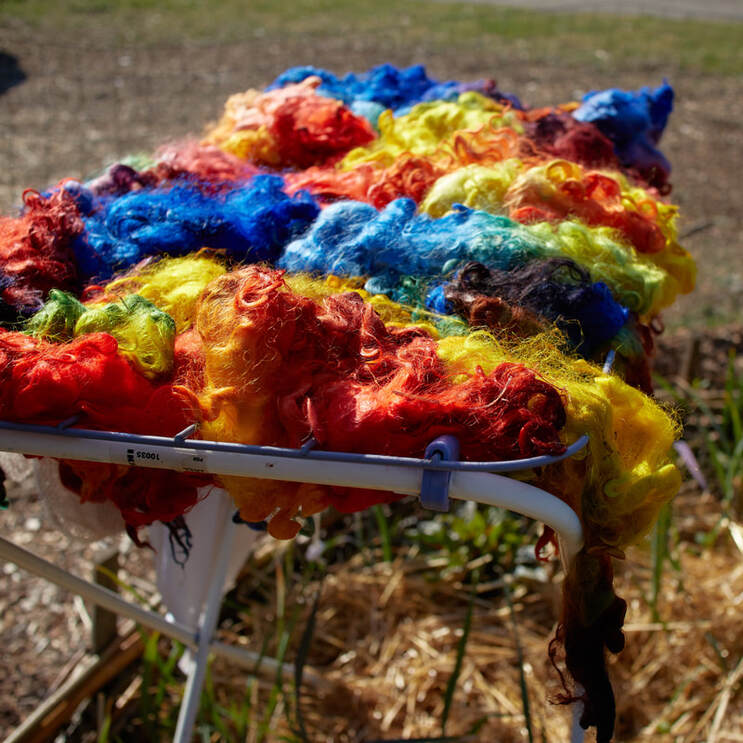|
12/5/2020 dyedAs social distancing restrictions ease in my province, I can't help but worry our personal social distancing is just at the beginning. Living with a family member who is immune suppressed and having several co-mobility factors myself, I suspect it will be months if not years before we can re-join society. But it's not too bad with five acres and a house full of introverts. We've been keeping busy. One of the things I set out to learn during lockdown is dyeing with acid dyes. I bought a couple of kits from Ashford where 10g of dye is enough to colour 1-kilo of fibre! With two years of fibre saved up for the local mill, which closed its doors last fall :( , I have a lot of wool (and alpaca, and llama, and silk, and...) to practice on. It's been a massive amount of fun, and I feel I'm only just scratching the surface of what is possible with this fantastic art. Click "read more" on the right to ...  But why acid dyeing? Well, I love natural dyeing, and the colours it creates are beautiful beyond measure. The depth and intensity of the colour from natural dyeing makes my heart soar! But for one problem - Natural dyes are really good at killing my garden. A lot of natural dyeing relies on heavy metal mordants to give the dye something to bite on to and affix to the fibre. Although there are ways to reduce this toxicity, I find to get the colour I seek; I still need to use these heavy metals to some extent. Metals that benefit the garden in trace amounts kill off plants in the quantities used in the mordant bath. And then there are the plants themselves. Plants that are benign in an everyday context, like onions skins, are super-concentrated in the dye bath. Even though the colour is absorbed into the fibre or yarn, there are other materials extracted from the plant left in the exhausted dye bath that leaves scorch marks on my lawn. Dyeing with natural dyes is a fast path to skin problems, not just during the dyeing process, but even after excessive washing, during the crafting process. My hands are more sensitive than most people, so I suspect it isn't a problem, but for me natural dyeing reduces what I can do with the fibre. All this factors into the most crucial aspect: TIME. We are in a very narrow window when the air is dry enough to dry a fleece in under two days, and the well still has enough water in it to wash and dye all this wool (and alpaca, and llama, and...). While washing and rinsing dyed wool, I place the dripping wool over the garden to water the strawberries. I have to make extra certain that the dye bath is exhausted and there is no pigment left in the water, but once it is, the water is safe for my garden, albeit, slightly acidic. All that's left is a weak solution of vinegar in water which is easily countered by applying a bit of wood ash to the garden. That's an integral part of this farm; everything has more than one job. Even the sheep, who grow that lovely wool, spend half an hour or so every night mowing the lawn for us - and pruning the trees at no extra cost. Although chemical dyes have their flaws, using acid dyes allows me to reuse the dye bath and rinse water on the garden which has been a great advantage during this hot, dry May. Part of the dyeing adventures involves restocking my etsy shop. More on that soon.
Would a Learning to Dye kit interest you? Let me know in the comments below.
Kerry
16/5/2020 08:18:46
Wow, I had no idea that natural dyeing used so much heavy metal. I've only used onion skins to dye eggs! Comments are closed.
|
CategoriesAll Airwell Angora Animal Fibre Boring Community Cotton Dryland Farming Dye Etsy Shop Experiments Fibre Prep Finance Flax Frugal Household Management Indigo Linen Local Cloth Mediterranean Climate Natural Dye Permaculture Plant Fibre Sewing Silk Tutorial Urban Fibre Vintage Wildcrafting Archives
February 2022
|
|
Created by Tracy Wandling of One Wing Freelance Graphic Design
|


 RSS Feed
RSS Feed
